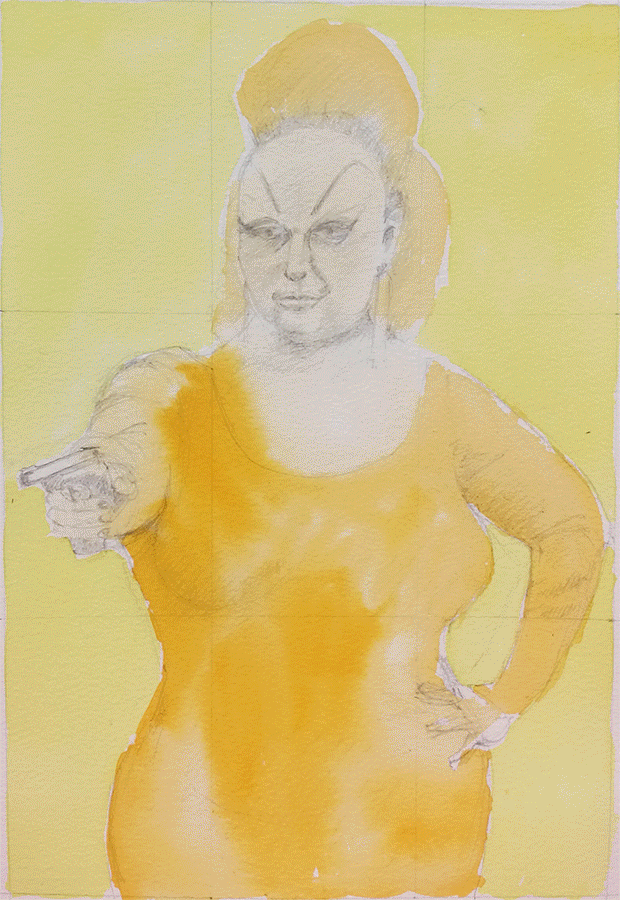Master’s in Illustration: Authorial Practice
Queer Iconography
I thought I’d share the first project I worked on for my master’s. It’s completely different from anything I’ve ever done before.
What I’ve done is create three 60-ish second looped animated gifs of icon-like works of art becoming and undoing. The subject of each work is a queer person. This is what I wrote about the first one, of Divine, in my research journal:
Every frame of each GIF is a stage in the process of making and unmaking an image of Divine from the publicity still of his breakthrough film Pink Flamingos. The image is never complete – I use different media, stick paper and images to it, paint over, pull the paper off, scrape paint off – and all the while the image jerks and warps because I took each photo from slightly different angles. I wasn’t attached to perfection and decided to be playful. There are some frames that show a quick flash of a religious icon of the Madonna and Child – a smiling reference to subliminal imagery, and to reinforce the fact that this work in continual progress is a religious icon itself.

Divine
Why?
Reading J Halberstam and Judith Butler, I have shown how queer lives can be seen as continually constructed and reconstructed, asserted and reasserted, in response to the monolithic societal norms. So I showed Divine in process, never whole, never finished.
Why Divine?
In Pink Flamingos Divine is “the filthiest person alive” and the whole film, billed as “an exercise in bad taste” attempts to be as abhorrent and offensive as possible. Divine is in competition to be the filthiest person with another couple, and naturally wins. The movie still is iconic – Divine is powerful, monstrous, beautiful in some weird way. My proposal aimed to focus on bringing the deviant into sacred space and Divine here is the epitome of deviance. Divine himself was someone who endured a huge amount of stigma because of his sexuality and I felt this powerful and tragic figure was irresistible for this project.
Why religious icons?
Because I love them. I love the low gold glowing from them as they flicker in the candlelight of Russian Orthodox churches. I am not Christian and was not raised that way but there is something numinous about them. More importantly, for this project, they represent something to aspire to – the lives of the saints are there to give moral instruction and support. Using Divine in this context is not ironic (although yes, I’ll grant you, it appears this way!) which leads me to…

Billy Tipton
What is this illustrating?
This project is my response to Mark Aguhar’s poem “Litanies to my Heavenly Brown Body”. The litanies express what is sacred – those things that are regarded often as profane – the queer, the fat, the people of colour, the unknowns. The litanies are assertions and reassertions of the inherent value, the inherent humanness (cf. Judith Butler) of the liminal people. I wanted to create a sacred space for queer liminal types, a space where they would be honoured and valued and yet still representative of the notion that queer lives must be continually made and remade in the face of heteronormativity.

Marsha P Johnson
How would this be displayed?
Ideally I would have four minute-long animations, that is, four animations that are 60 seconds long each, one queer saint for each. I submitted three in total – Divine, Billy Tipton (a jazz band leader who achieved some fame, married several women and only after death was discovered to have been assigned female at birth), and Marsha P Johnson (a black queer femme who is alleged to have started the Stonewall Riot). I imagine they would be back-projected through something like Polydraw, about a metre high, on the four walls of a small dark square room. There would be candles and incense. I imagine the space being a cube of two metres at every edge (though, it occurs to me, it would need a door).
I’ll finish this post with a quote from Judith Butler, from Undoing Gender:
“[Queer persons] make us not only question what is real, and what “must” be, but they also show us how the norms that govern contemporary notions of reality can be questioned and how new modes of reality can become instituted. These practices of instituting new modes of reality take place in part through the scene of embodiment, where the body is not understood as a static and accomplished fact, but as an ageing process, a mode of becoming that, in becoming otherwise, exceeds the norm, reworks the norm, and makes us see how realities to which we thought we were confined are not written in stone. Some people have asked me what is the use of increasing possibilities for gender. I tend to answer: Possibility is not a luxury, it is as crucial as bread. I think we should not underestimate what the thought of the possible does for those for whom the very issue of survival is more urgent. If the answer to the question, is life possible, is yes, that is surely something significant.”
